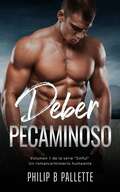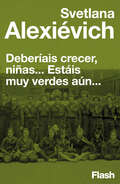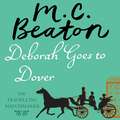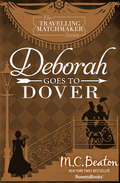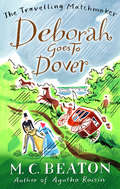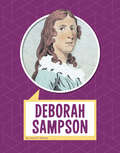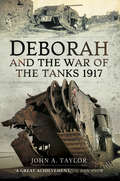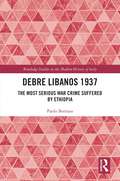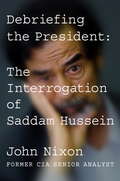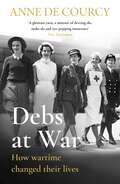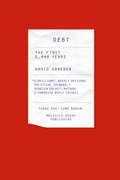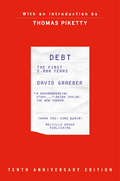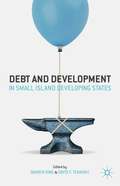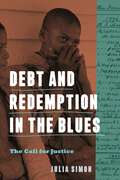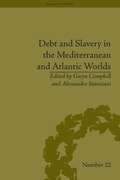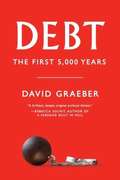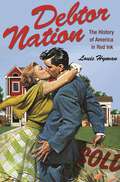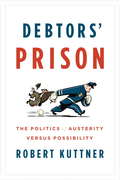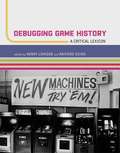- Table View
- List View
Debbie Mazzuca Bundle: Lord of the Isles, Warrior of the Isles & King of the Isl es
by Debbie MazzucaAfter traveling to Scotland on business, the bed of a highland laird is the last place Ali Graham expected to wake up. But there's no mistaking the irresistibly masculine Scottish Highlander whose chamber she's accidentally infiltrated--or the severe wound he's suffered in battle. As a doctor, Ali knows how to heal his injury, how to nurse his body back to health. What she doesn't know is how to heal his heart. . . Bound By Duty In a time of raids and ransoms, Aidan MacLeod is responsible for a formidable Scottish keep and all the people within. Yet the fearless Highland laird never forgets his charge to shield his young half-brother from the grave consequences of his tragic birth. Linked By Fate But an alluring stranger known only as Syrena could undo all of Aidan's defenses. For Syrena has vowed to bring Aidan's brother to a realm far from the Scotland of their understanding. To succeed, she is at Aidan's mercy. She'll find him a bride if it's the last thing she does. And it very well might be. Evangeline may be powerfully persuasive in her way, but convincing the notoriously wild Highland king Lachlan MacLeod to strengthen his alliances with a strategic marriage seems to be asking the impossible. Stubborn and proud, Lachlan seems determined to go against her will, even if it means endangering the people he's sworn to protect and the enchanted isle that has already seen so much discord.
Deber pecaminoso: Volumen 1 de la serie "Sinful" Un romance/misterio humeante (Father Grant Stevenson Series Vol. 1 #1)
by Philip B PalletteEn vida, todo hombre es capaz de pecar. Pero los pecados de otros llevan su propia vida a la ruina? Grant Stevenson sabe lo que quiere de la vida. Con destino a una vida de servicio a su fe y a la iglesia, Grant se muestra prometedor como sacerdote joven y devoto. Pero ningún hombre está realmente a salvo de la tentación. Pronto, la pasión y la lujuria invaden la vida de Grant, enviando el futuro que había planeado él mismo en la confusión. Y cuando la pasión de repente se convierte en asesinato, Grant rápidamente se encuentra hundido profundamente en un mundo de engaño, crimen y pecado. Grant trata de distanciarse y dejar atrás los acontecimientos de su ahora turbulento pasado. encontrar un nuevo propósito en su vida. Pero no hay descanso para los malvados, y no hay distancia suficiente para que Grant pueda escapar. Pronto, se adentra más en el misterio detrás del crimen cometido en su parroquia. Puede que no haya cometido el crimen él mismo, pero Grant sabe que sus manos están lejos de estar limpio de culpa, ya que él también sabe lo que significa pecar. Ahora, debe mantener su ingenio sobre él y hacer todo lo posible para evitar más daños. viniendo a las personas que él cuida. Sin embargo, ¿qué pensarían de él si supieran la verdad de su propia indiscreciones? Sinful Duty es una historia convincente sobre la lucha entre los justos y los conducidos al pecado. Will Grant desenmascarará al responsable de la violencia que ha destrozado su vida, a tiempo para salvar otra vida? ¿O la amenaza ya está demasiado cerca de su hogar? Para sumergirte en esta apasionante historia de pasión y misterio, desplácese hacia arriba y haga clic en "Agregar al carrito" ahora mismo. ¿Qué se necesita para descubrir la verdad?
Deberíais crecer, niñas... estáis muy verdes aún
by Svetlana AlexievichLa ganadora del Premio Nobel de literatura, Svetlana Alexiévich, le da vida a las numerosas voces de aquellas mujeres silenciadas por la guerra. Deberíais crecer, niñas... Estáis muy verdes aún... Es uno de los fragmentos del ensayo La guerra no tiene rostro de mujer: un corpus formado por los desgarradores testimonios de aquellas que vivieron la guerra en sus propias carnes. Mujeres que lucharon, que resistieron, que fueron voluntarias, que fueron arrastradas; mujeres que salvaron y arrebataron vidas durante la Segunda Guerra Mundial. «Estaba embarazada del segundo... Mi hijo tenía dos años, yo estaba encinta. Estalló la guerra. Mi marido combatía en el frente. Me fui al pueblo donde vivían mis padres e hice... Ya me entiende... Aborté... En aquella época estaba prohibido... ¿Cómo podía dar a luz? Alrededor había tanto dolor... ¡La guerra! ¿Cómo se puede dar a luz si te rodea la muerte?»
Deberíais crecer, niñas... estáis muy verdes aún
by Svetlana AlexievichLa ganadora del Premio Nobel de literatura, Svetlana Alexiévich, le da vida a las numerosas voces de aquellas mujeres silenciadas por la guerra. Deberíais crecer, niñas... Estáis muy verdes aún... Es uno de los fragmentos del ensayo La guerra no tiene rostro de mujer: un corpus formado por los desgarradores testimonios de aquellas que vivieron la guerra en sus propias carnes. Mujeres que lucharon, que resistieron, que fueron voluntarias, que fueron arrastradas; mujeres que salvaron y arrebataron vidas durante la Segunda Guerra Mundial. «Estaba embarazada del segundo... Mi hijo tenía dos años, yo estaba encinta. Estalló la guerra. Mi marido combatía en el frente. Me fui al pueblo donde vivían mis padres e hice... Ya me entiende... Aborté... En aquella época estaba prohibido... ¿Cómo podía dar a luz? Alrededor había tanto dolor... ¡La guerra! ¿Cómo se puede dar a luz si te rodea la muerte?»
Deborah Goes to Dover (The Travelling Matchmaker #5)
by Marion ChesneyWhen Miss Hannah Pym meets the tomboyish Lady Deborah Western on the coach to Dover, she is certain that, with a little guidance, Deb will attract many suitors--perhaps even her handsome neighbor the Earl of Ashton. Marion Chesney has won the Romantic Times Award for Outstanding Regency Series Writer.
Deborah Goes to Dover (The Travelling Matchmaker Series #5)
by M.C. BeatonThe fifth book in M.C. Beaton's charming Travelling Matchmaker series. The engaging Miss Hannah Pym delights all as she resumes her matchmaking adventures aboard the English stage - when lonely hearts chance across her intrepid path they're sure to find themselves en route for romance!Destined for Dover, Miss Pym has her matchmaking work cut out for her when she encounters the pretty but hoydenish Lady Deborah Western! Encouraged by an unruly twin brother, the spirited, golden-haired Deborah seems set on dressing and acting the tomboy, much to the dismay of her handsome neighbor, the Earl of Ashton...To Deb, the earl is a dull stick, always lecturing on the behavior of a proper lady. But her desire to fish, hunt, and ride astride is quickly replaced with more romantic notions when the tall, green-eyed earl challenges her to a horse race and wins himself an unforgettable kiss. Miss Pym can't resist the opportunity to match-make, and with the help of her clever maneuverings, Lady Deborah will soon be well and truly matched - perhaps even to the earl himself!'Romance fans are in for a treat' - Booklist'[M. C. Beaton] is the best of the Regency writers' - Kirkus Reviews
Deborah Goes to Dover: A Novel Of Regency England - Being The Fifth Volume Of The Traveling Matchmaker (The Travelling Matchmaker Series #5)
by M. C. BeatonIn this &“lighthearted Regency romp,&” a determined matchmaker has her hands full (Publishers Weekly) . . . Traveling matchmaker Miss Pym is on a coach trip to Dover when she comes across a young boy . . . who is, in fact, Lady Deborah Western. The hoyden is in disguise while her twin brother smuggles her to a prizefight . . . It&’s up to Miss Pym to step in and guard Lady Deborah&’s reputation after her ruse is discovered—while at the same time trying to discourage her footman from taking part in a boxing competition himself. After a handsome earl steps into the fray, Miss Pym finds herself juggling two matchmaking challenges—and engaging in some fights of her own . . . This &“frothily entertaining&” tale, originally published under the name Marion Chesney, is a delightful journey to Regency England from a beloved New York Times–bestselling author (Publishers Weekly).
Deborah Goes to Dover: A Novel Of Regency England - Being The Fifth Volume Of The Traveling Matchmaker (The Travelling Matchmaker Series #5)
by M.C. BeatonThe fifth book in M.C. Beaton's charming Travelling Matchmaker series. The engaging Miss Hannah Pym delights all as she resumes her matchmaking adventures aboard the English stage - when lonely hearts chance across her intrepid path they're sure to find themselves en route for romance!Destined for Dover, Miss Pym has her matchmaking work cut out for her when she encounters the pretty but hoydenish Lady Deborah Western! Encouraged by an unruly twin brother, the spirited, golden-haired Deborah seems set on dressing and acting the tomboy, much to the dismay of her handsome neighbor, the Earl of Ashton...To Deb, the earl is a dull stick, always lecturing on the behavior of a proper lady. But her desire to fish, hunt, and ride astride is quickly replaced with more romantic notions when the tall, green-eyed earl challenges her to a horse race and wins himself an unforgettable kiss. Miss Pym can't resist the opportunity to match-make, and with the help of her clever maneuverings, Lady Deborah will soon be well and truly matched - perhaps even to the earl himself!'Romance fans are in for a treat' - Booklist'[M. C. Beaton] is the best of the Regency writers' - Kirkus Reviews
Deborah Sampson (Biographies)
by Laura MurrayHow much do you know about Deborah Sampson? Find out the facts you need to know about this woman who fought in the Revolutionary War. You’ll learn about the early life, challenges, and major accomplishments of this important American.
Deborah and the War of the Tanks
by John TaylorDeborah is a British First World War tank that rose from the grave after taking part in one of the most momentous battles in history. In November 1917 she played a leading role in the first successful massed tank attack at Cambrai. Eighty years later, in a remarkable feat of archaeology, the tanks buried remains were rediscovered and excavated, and are now preserved as a memorial to the battle and to the men who fought in it. John Taylors book tells the tale of the tank and her crew and tracks down their descendants to uncover a human story every bit as compelling as the military one.
Debre Libanos 1937: The Most Serious War Crime Suffered by Ethiopia (Routledge Studies in the Modern History of Italy)
by Paolo BorrusoThis volume calls attention to the worst massacre of Christians that has occurred on the African continent, a 1937 attack on the monastic village of Debre Libanos that has previously been hidden from public knowledge. Between 20 and 29 May 1937, about 2000 monks and pilgrims, considered "conniving" in the attack on the fascist Italian viceroy Rodolfo Graziani, were killed in Ethiopia. The attack on Debre Libanos, the most famous sanctuary of Ethiopian Christianity, far exceeded the logic of a strictly military operation. It represented the apex of wide-ranging repressive action, aimed at crushing the Ethiopian resistance and striking at the heart of the Christian tradition for its historical link with the imperial power of the Negus. Although known to scholars, the episode was totally removed from national historical memory. Now available in English, this book’s analysis of the events culminating in the massacre, including the cover-up afterward, is a necessary record for scholars of European colonialism, Christian history, and colonial Africa.
Debriefing the President: The Interrogation of Saddam Hussein
by John NixonIn December 2003, after one of the largest, most aggressive manhunts in history, US military forces captured Iraqi president Saddam Hussein near his hometown of Tikrit. Beset by body-double rumors and false alarms during a nine-month search, the Bush administration needed positive identification of the prisoner before it could make the announcement that would rocket around the world. At the time, John Nixon was a senior CIA leadership analyst who had spent years studying the Iraqi dictator. Called upon to make the official ID, Nixon looked for telltale scars and tribal tattoos and asked Hussein a list of questions only he could answer. The man was indeed Saddam Hussein, but as Nixon learned in the ensuing weeks, both he and America had greatly misunderstood just who Saddam Hussein really was. Debriefing the President presents an astounding, candid portrait of one of our era’s most notorious strongmen. Nixon, the first man to conduct a prolonged interrogation of Hussein after his capture, offers expert insight into the history and mind of America’s most enigmatic enemy. After years of parsing Hussein’s leadership from afar, Nixon faithfully recounts his debriefing sessions and subsequently strips away the mythology surrounding an equally brutal and complex man. His account is not an apology, but a sobering examination of how preconceived ideas led Washington policymakers—and the Bush White House—astray. Unflinching and unprecedented, Debriefing the President exposes a fundamental misreading of one of the modern world’s most central figures and presents a new narrative that boldly counters the received account.From the Trade Paperback edition.
Debs at War: 1939-1945
by Anne de CourcyAn extraordinary account - from firsthand sources - of upper class women and the active part they took in the WarPre-war debutantes were members of the most protected, not to say isolated, stratum of 20th-century society: the young (17-20) unmarried daughters of the British upper classes. For most of them, the war changed all that for ever. It meant independence and the shock of the new, and daily exposure to customs and attitudes that must have seemed completely alien to them. For many, the almost military regime of an upper class childhood meant they were well suited for the no-nonsense approach needed in wartime. This book records the extraordinary diversity of challenges, shocks and responsibilities they faced - as chauffeurs, couriers, ambulance-drivers, nurses, pilots, spies, decoders, factory workers, farmers, land girls, as well as in the Women's Services. How much did class barriers really come down? Did they stick with their own sort? And what about fun and love in wartime - did love cross the class barriers?
Debs at War: 1939-1945 (WOMEN IN HISTORY)
by Anne de CourcyAn extraordinary account - from firsthand sources - of upper class women and the active part they took in the WarPre-war debutantes were members of the most protected, not to say isolated, stratum of 20th-century society: the young (17-20) unmarried daughters of the British upper classes. For most of them, the war changed all that for ever. It meant independence and the shock of the new, and daily exposure to customs and attitudes that must have seemed completely alien to them. For many, the almost military regime of an upper class childhood meant they were well suited for the no-nonsense approach needed in wartime. This book records the extraordinary diversity of challenges, shocks and responsibilities they faced - as chauffeurs, couriers, ambulance-drivers, nurses, pilots, spies, decoders, factory workers, farmers, land girls, as well as in the Women's Services. How much did class barriers really come down? Did they stick with their own sort? And what about fun and love in wartime - did love cross the class barriers?
Debt
by David GraeberBefore there was money, there was debt Every economics textbook says the same thing: Money was invented to replace onerous and complicated barter systems--to relieve ancient people from having to haul their goods to market. The problem with this version of history? There's not a shred of evidence to support it. Here anthropologist David Graeber presents a stunning reversal of conventional wisdom. He shows that for more than 5,000 years, since the beginnings of the first agrarian empires, humans have used elaborate credit systems to buy and sell goods--that is, long before the invention of coins or cash. It is in this era, Graeber argues, that we also first encounter a society divided into debtors and creditors. Graeber shows that arguments about debt and debt forgiveness have been at the center of political debates from Italy to China, as well as sparking innumerable insurrections. He also brilliantly demonstrates that the language of the ancient works of law and religion (words like "guilt," "sin," and "redemption") derive in large part from ancient debates about debt, and shape even our most basic ideas of right and wrong. We are still fighting these battles today without knowing it. Debt: The First 5,000 Years is a fascinating chronicle of this little known history--as well as how it has defined human history, and what it means for the credit crisis of the present day and the future of our economy.From the Hardcover edition.
Debt - Updated and Expanded: The First 5,000 Years
by David GraeberNow in paperback, the updated and expanded edition : David Graeber’s “fresh . . . fascinating . . . thought-provoking . . . and exceedingly timely” (Financial Times) history of debt Here anthropologist David Graeber presents a stunning reversal of conventional wisdom: he shows that before there was money, there was debt. For more than 5,000 years, since the beginnings of the first agrarian empires, humans have used elaborate credit systems to buy and sell goods—that is, long before the invention of coins or cash. It is in this era, Graeber argues, that we also first encounter a society divided into debtors and creditors. Graeber shows that arguments about debt and debt forgiveness have been at the center of political debates from Italy to China, as well as sparking innumerable insurrections. He also brilliantly demonstrates that the language of the ancient works of law and religion (words like “guilt,” “sin,” and “redemption”) derive in large part from ancient debates about debt, and shape even our most basic ideas of right and wrong. We are still fighting these battles today without knowing it.
Debt And Development In Small Island Developing States
by Damien King David F. TennantDebt and Development in Small Island Developing States draws on the expertise of established researchers and public officials from within the SIDS community to answer the following pressing questions related to sustainability, debt accumulation, and prospects for future growth.
Debt and Redemption in the Blues: The Call for Justice (American Music History)
by Julia SimonThis volume explores concepts of freedom and bondage in the blues and argues that this genre of music explicitly calls for a reckoning while expressing faith in a secular justice to come. Placing blues music within its historical context of the post-Reconstruction South, Jim Crow America, and the civil rights era, Julia Simon finds a deep symbolism in the lyrical representations of romantic and sexual betrayal. The blues calls out and indicts the tangled web of deceit and entrapment constraining the physical, socioeconomic, and political movement of African Americans. Surveying blues music from the 1920s to the early twenty-first century, Simon’s analyses focus on economic relations, such as sharecropping, house contract sales, debt peonage, criminal surety, and convict lease. She demonstrates how the music reflects this exploitative economic history and how it is shaped by commodification under racialized capitalism. As Simon assesses the lyrics, technique, and styles of a wide range of blues musicians, including Bessie Smith, Blind Lemon Jefferson, Big Bill Broonzy, Muddy Waters, B. B. King, Albert Collins, and Kirk Fletcher, she argues forcefully that the call for racial justice is at the heart of the blues.A highly sophisticated interpretation of the blues tradition steeped in musicology, social history, and critical-cultural hermeneutics, Debt and Redemption not only clarifies blues as an aesthetic tradition but, more importantly, proves that it advances a theory of social and economic development and change.
Debt and Slavery in the Mediterranean and Atlantic Worlds (Financial History #22)
by Alessandro StanzianiFilling a significant gap in the historiography, the essays in this volume show that debt slavery has played a crucial role in the economic history of numerous societies which continues even today.
Debt in Times of Crisis: Does Economic Crisis Really Impact Debt?
by Thomas PoufinasDebt, private and public, and in particular excessive debt, has been debated to be one of the root causes of economic crises. At the same time, economic crises are believed to lead to an increase of debt. This book, through a range of contributors, explores certain constituents of an economy and attempts to identify their contribution to debt (public and private), especially in times of crisis; namely, bonds, tariffs, social security and non-performing loans (NPLs). Furthermore, it captures the (implicit) impact of the demography on debt through tariffs and social security and investigates the effect of quantitative easing/purchase programs and as well as crises on debt. In addition, the (cost of the) reserve that a state may want to provision for, in order to secure its economy from defaulting within a certain time horizon, is also addressed and calculated. This calculation offers an alternative valuation, or pricing, of (excess) debt (default protection). This book aims to offer a comparative study of countries – especially those with a history of excessive debt - and intends to realize whether an economic crisis can genuinely deteriorate debt, or whether the debt unsustainability is preexisting to the crisis. It will be relevant to students and researchers interested in economic policy and growth.
Debt: Ethics, the Environment, and the Economy
by Peter Y. Paik Merry Wiesner-HanksFrom personal finance and consumer spending to ballooning national expenditures on warfare and social welfare, debt is fundamental to the dynamics of global capitalism. The contributors to this volume explore the concept of indebtedness in its various senses and from a wide range of perspectives. They observe that many views of ethics, citizenship, and governance are based on a conception of debts owed by one individual to others; that artistic and literary creativity involves the artist's dialogue with the works of the past; and that the specter of catastrophic climate change has underscored the debt those living in the present owe to future generations.
Debt: The First 5,000 Years
by David GraeberEvery economics textbook says the same thing: Money was invented to replace onerous and complicated barter systems-to relieve ancient people from having to haul their goods to market. The problem with this version of history? There's not a shred of evidence to support it. Here anthropologist David Graeber presents a stunning reversal of conventional wisdom. He shows that for more than 5,000 years, since the beginnings of the first agrarian empires, humans have used elaborate credit systems to buy and sell goods-that is, long before the invention of coins or cash. It is in this era, Graeber argues, that we also first encounter a society divided into debtors and creditors. Graeber shows that arguments about debt and debt forgiveness have been at the center of political debates from Italy to China, as well as sparking innumerable insurrections. He also brilliantly demonstrates that the language of the ancient works of law and religion (words like "guilt," "sin," and "redemption") derive in large part from ancient debates about debt, and shape even our most basic ideas of right and wrong. We are still fighting these battles today without knowing it. Debt: The First 5,000 Years is a fascinating chronicle of this little known history-as well as how it has defined human history, and what it means for the credit crisis of the present day and the future of our economy.
Debtor Nation: The History of America in Red Ink (Politics and Society in Modern America #87)
by Louis HymanThe story of personal debt in modern AmericaBefore the twentieth century, personal debt resided on the fringes of the American economy, the province of small-time criminals and struggling merchants. By the end of the century, however, the most profitable corporations and banks in the country lent money to millions of American debtors. How did this happen? The first book to follow the history of personal debt in modern America, Debtor Nation traces the evolution of debt over the course of the twentieth century, following its transformation from fringe to mainstream—thanks to federal policy, financial innovation, and retail competition.How did banks begin making personal loans to consumers during the Great Depression? Why did the government invent mortgage-backed securities? Why was all consumer credit, not just mortgages, tax deductible until 1986? Who invented the credit card? Examining the intersection of government and business in everyday life, Louis Hyman takes the reader behind the scenes of the institutions that made modern lending possible: the halls of Congress, the boardrooms of multinationals, and the back rooms of loan sharks. America's newfound indebtedness resulted not from a culture in decline, but from changes in the larger structure of American capitalism that were created, in part, by the choices of the powerful—choices that made lending money to facilitate consumption more profitable than lending to invest in expanded production.From the origins of car financing to the creation of subprime lending, Debtor Nation presents a nuanced history of consumer credit practices in the United States and shows how little loans became big business.
Debtors' Prison
by Robert KuttnerOne of our foremost economic thinkers challenges a cherished tenet of today's financial orthodoxy: that spending less, refusing to forgive debt, and shrinking government--"austerity"--is the solution to a persisting economic crisis like ours or Europe's, now in its fifth year. Since the collapse of September 2008, the conversation about economic recovery has centered on the question of debt: whether we have too much of it, whose debt to forgive, and how to cut the deficit. These questions dominated the sound bites of the 2012 U.S. presidential election, the fiscal-cliff debates, and the perverse policies of the European Union. Robert Kuttner makes the most powerful argument to date that these are the wrong questions and that austerity is the wrong answer. Blending economics with historical contrasts of effective debt relief and punitive debt enforcement, he makes clear that universal belt-tightening, as a prescription for recession, defies economic logic. And while the public debt gets most of the attention, it is private debts that crashed the economy and are sandbagging the recovery--mortgages, student loans, consumer borrowing to make up for lagging wages, speculative shortfalls incurred by banks. As Kuttner observes, corporations get to use bankruptcy to walk away from debts. Homeowners and small nations don't. Thus, we need more public borrowing and investment to revive a depressed economy, and more forgiveness and reform of the overhang of past debts. In making his case, Kuttner uncovers the double standards in the politics of debt, from Robinson Crusoe author Daniel Defoe's campaign for debt forgiveness in the seventeenth century to the two world wars and Bretton Woods. Just as debtors' prisons once prevented individuals from surmounting their debts and resuming productive life, austerity measures shackle, rather than restore, economic growth--as the weight of past debt crushes the economy's future potential. Above all, Kuttner shows how austerity serves only the interest of creditors--the very bankers and financial elites whose actions precipitated the collapse. Lucid, authoritative, provocative--a book that will shape the economic conversation and the search for new solutions. From the Hardcover edition.
Debugging Game History: A Critical Lexicon
by Raiford Guins Henry LowoodEven as the field of game studies has flourished, critical historical studies of games have lagged behind other areas of research. Histories have generally been fact-by-fact chronicles; fundamental terms of game design and development, technology, and play have rarely been examined in the context of their historical, etymological, and conceptual underpinnings. This volume attempts to "debug" the flawed historiography of video games. It offers original essays on key concepts in game studies, arranged as in a lexicon -- from "Amusement Arcade" to "Embodiment" and "Game Art" to "Simulation" and "World Building." Written by scholars and practitioners from a variety of disciplines, including game development, curatorship, media archaeology, cultural studies, and technology studies, the essays offer a series of distinctive critical "takes" on historical topics. The majority of essays look at game history from the outside in; some take deep dives into the histories of play and simulation to provide context for the development of electronic and digital games; others take on such technological components of games as code and audio. Not all essays are history or historical etymology -- there is an analysis of game design, and a discussion of intellectual property -- but they nonetheless raise questions for historians to consider. Taken together, the essays offer a foundation for the emerging study of game history. ContributorsMarcelo Aranda, Brooke Belisle, Caetlin Benson-Allott, Stephanie Boluk, Jennifer deWinter, J. P. Dyson, Kate Edwards, Mary Flanagan, Jacob Gaboury, William Gibbons, Raiford Guins, Erkki Huhtamo, Don Ihde, Jon Ippolito, Katherine Isbister, Mikael Jakobsson, Steven E. Jones, Jesper Juul, Eric Kaltman, Matthew G. Kirschenbaum, Carly A. Kocurek, Peter Krapp, Patrick LeMieux, Henry Lowood, Esther MacCallum-Stewart, Ken S. McAllister, Nick Monfort, David Myers, James Newman, Jenna Ng, Michael Nitsche, Laine Nooney, Hector Postigo, Jas Purewal, Reneé H. Reynolds, Judd Ethan Ruggill, Marie-Laure Ryan, Katie Salen Tekinbas, Anastasia Salter, Mark Sample, Bobby Schweizer, John Sharp, Miguel Sicart, Rebecca Elisabeth Skinner, Melanie Swalwell, David Thomas, Samuel Tobin, Emma Witkowski, Mark J.P. Wolf

